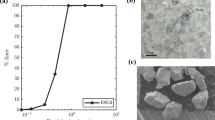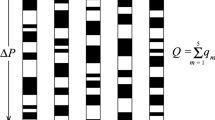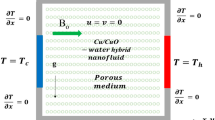Abstract
Solutal convection in a horizontal layer filled with porous media with horizontal seepage of a mixture is investigated considering the solute immobilization and clogging. A flow through porous media is modelled within the standard Darcy–Boussinesq model, and the immobilization process is described by the mobile/immobile media (MIM) approach. To describe the clogging process, the present model takes into account and the dependence of media permeability on porosity within the Carman–Kozeny equation. The presence of immobile (or adsorbed) particles of the solute decreases the porosity of media, and porous media become less permeable. The variation of porosity is modelled by a linear function of solute concentration in the immobile phase. We consider the case of high solute concentrations, in which the immobilization is described by the nonlinear MIM (mobile/immobile media) model. As a result, it was shown that the immobilization leads to the stabilization of the homogeneous filtration regime and to slowing down of the perturbation dynamics. The stability maps were plotted in a wide range of system parameters. The results showed that for some specific value of clean media porosity the system becomes most unstable and dynamics of perturbations (frequency of oscillations) is most intensive. This value corresponds to the minimal effect of porosity change to variation of permeability due to the immobilization.








Similar content being viewed by others
References
Bories, S.A., Combarnous, M.A.: Natural convection in a sloping porous layer. JFM 57, 63–79 (1973)
Carman, P.C.: Fluid flow through granular beds. Trans. Inst. Chem. Eng. 15, 150 (1937)
De Smedt, F., Wierenga, P.J.: Mass transfer in porous media with immobile water. J. Hydrol. 41, 59–67 (1979)
Deans, H.A.: A mathematical model for dispersion in the direction of flow in porous media. Soc. Petrol. Eng. J. 3, 49 (1963)
Elder, J.W.: Steady free convection in a porous medium heated from below. JFM 27, 29–48 (1967)
Elimelech, M., Gregory, J., Jia, X.: Particle Deposition and Aggregation: Measurement, Modelling and Simulation. Butterworth-Heinemann, Oxford (2013)
Goldshtik, M.A., Stern, V.N.: Hydrodynamic Stability and Turbulence. Nauka, Novosibirsk (1977). (in Russian)
Gouze, P., Melean, Y., Le Borgne, T., Dentz, M., Carrera, J.: Non-Fickian dispersion in porous media explained by heterogeneous microscale matrix diffusion. Water Resour. Res. 44, 11 (2008)
Horton, C., Rogers, F.: Convection currents in a porous medium. J. Appl. Phys. 16, 367 (1945)
Kay, B.D., Elrick, D.E.: Adsorption and movement of lindane in soils. Soil Sci. 104, 314–322 (1967)
Klimenko, L.S., Maryshev, B.S.: Effect of solute immobilization on the stability problem within the fractional model in the solute analog of the Horton–Rogers–Lapwood problem. Eur. Phys. J. E 40, 104 (2017)
Klimenko, L.S., Maryshev, B.S.: Numerical simulation of microchannel blockage by the random walk method. Chem. Eng. J. 381, (2020)
Lapwood, E.R.: Convection of a fluid in a porous medium. Math. Proc. Camb. Philos. Soc. 44, 508–521 (1948)
Liang, Y., Wen, B., Hesse, M.A., DiCarlo, D.: Effect of dispersion on solutal convection in porous media. Geophys. Res. Lett. 45, 9690–9698 (2018)
Lindstrom, F.T., Haque, R., Freed, V.H., Boersma, L.: The movement of some herbicides in soils. Linear diffusion and convection of chemicals in soils. Environ. Sci Technol. 1, 561–565 (1967)
Martinez-Vertel, J.J., Villaquiran-Vargas, A.P., Villar-Garcia, A., Moreno-Diaz, D.F., Rodriguez-Castelblanco, A.X.: Polymer adsorption isotherms with NaCl and CaCl 2 on kaolinite substrates. DYNA 86, 66–73 (2019)
Maryshev, B.S.: The effect of sorption on linear stability for the solutal Horton–Rogers–Lapwood problem. Transp. Porous Media 109, 747 (2015)
Maryshev, B.: A Non-linear model for solute transport, accounting for sub-diffusive concentration decline and sorption saturation. Math. Model. Nat. Phenom. 11, 179–190 (2016)
Maryshev, B.S., Klimenko, L.S.: An effect of sorption on convective modes selection for solutal convection in a rectangular porous channel. Transp. Porous Media 127, 309 (2019)
Maryshev, B., Cartalade, A., Latrille, C., Neel, M.C.: Identifying space-dependent coefficients and the order of fractionality in fractional advection–diffusion equation. Transp. Porous Media 116, 53–71 (2017)
Nield, D.A., Bejan, A.: Convection in Porous Media. Springer, New York (2017)
Parvan, A., Jafari, S., Rahnama, M., Raoof, A.: Insight into particle retention and clogging in porous media; a pore scale study using lattice Boltzmann method. Adv. Water Resour. 138, (2020)
Prats, M.: The effect of horizontal fluid flow on thermally induced convection currents in porous mediums. J. Geophys. Res. 71, 4835 (1966)
Roth, E.J., Gilbert, B., Mays, D.C.: Colloid deposit morphology and clogging in porous media: fundamental insights through investigation of deposit fractal dimension. Environ. Sci. Technol. 49, 12263 (2015)
Selim, H.M., Amacher, M.C.: Reactivity and Transport of Heavy Metals in Soils. CRC/lewis, Boca Raton (1997)
Van Genuchten, MTh, Wierenga, P.J.: Mass transfer studies in sorbing porous media I. Analytical solutions. Soil Sci. Soc. Am. J. 40, 473 (1976)
Acknowledgements
The work was supported by the Russian Science Foundation (Grant 20-11-20125).
Author information
Authors and Affiliations
Corresponding author
Additional information
Publisher's Note
Springer Nature remains neutral with regard to jurisdictional claims in published maps and institutional affiliations.
Appendices
Appendix A: Verification of the Numerical Calculations for the Case with Constant Permeability
The equation system for neutral perturbations (13) for the case of \(\kappa =\kappa _0=\kappa ^0=\mathrm{const}\) reads
For the limiting case of the saturated porous media (\(b\ll 1\) and \(Q=q_{C0}=\mathrm{const}\)), Eq. (14) after substitution (9) becomes
and using the perturbations in form of \(C,\varPsi \sim \sin (n\pi y)\) the well-known solution Prats (1966) can be obtained
While for the limiting case of the convection with small initial concentration (\(C_0\ll \phi _0,q_0\)), Eq. (14) together with (10) correspond to
The Eq. (14) can be reduced to one complex equation for \(Q,C,\varPsi \sim \sin (n\pi y)\) in the form of
which is coincided with Eq. (10) in Maryshev (2015) up to replacement \(aq_{C0}\rightarrow a\).
Appendix B: The Case Without Adsorption
We shall rewrite solution Eq. (8) for the case \(a=0\) (the immobilization effect is excluded)
Then, equations for normal neutral perturbations (13) are
The last equation has only trivial solution: \(Q=0\). Thus, substitution of \(C, \varPsi \sim \sin {\pi y}\) gives
Finally,
which is a well-known solution Prats (1966).
Appendix C: The Case Without Desorption
For the case \(b=0\) (desorption is absent), solution Eq. (8) reads
Then, equations for normal neutral perturbations (13) become
The last equation has only trivial solution: \(Q=0\). Thus, substitution of \(C, \varPsi \sim \sin {\pi y}\) gives
Rights and permissions
About this article
Cite this article
Maryshev, B.S., Klimenko, L.S. Convective Stability of a Net Mass Flow Through a Horizontal Porous Layer with Immobilization and Clogging. Transp Porous Med 137, 667–682 (2021). https://doi.org/10.1007/s11242-021-01582-6
Received:
Accepted:
Published:
Issue Date:
DOI: https://doi.org/10.1007/s11242-021-01582-6




